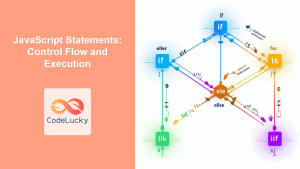In the world of web development, performance is king. As applications grow more complex and user expectations rise, optimizing JavaScript code for better execution becomes crucial. This comprehensive guide will explore various techniques and best practices to enhance your JavaScript performance, ensuring your applications run smoothly and efficiently.
Understanding JavaScript Performance
Before diving into optimization techniques, it's essential to understand what affects JavaScript performance. Several factors contribute to how quickly your code executes:
- 🔍 Parsing time: How long it takes for the JavaScript engine to read and understand your code.
- ⚙️ Compilation time: The time required to convert your code into machine-readable instructions.
- 🚀 Execution time: The actual runtime of your code.
- 🧠 Memory usage: How efficiently your code utilizes available memory.
By focusing on these areas, we can significantly improve the overall performance of our JavaScript applications.
1. Minimize DOM Manipulation
The Document Object Model (DOM) is a crucial part of web development, but excessive manipulation can lead to performance bottlenecks. Here are some strategies to optimize DOM interactions:
Use Document Fragments
When adding multiple elements to the DOM, use document fragments to minimize reflows and repaints:
const fragment = document.createDocumentFragment();
for (let i = 0; i < 1000; i++) {
const element = document.createElement('div');
element.textContent = `Item ${i}`;
fragment.appendChild(element);
}
document.body.appendChild(fragment);
This approach batches DOM updates, resulting in better performance compared to adding elements one by one.
Leverage CSS for Animations
Instead of using JavaScript for animations, utilize CSS transitions and animations when possible:
.animated-element {
transition: transform 0.3s ease-in-out;
}
element.classList.add('animated-element');
element.style.transform = 'translateX(100px)';
CSS-based animations are typically smoother and more efficient than JavaScript-driven ones.
2. Optimize Loops and Iterations
Loops are fundamental in programming, but they can be a source of performance issues if not implemented correctly.
Use for…of for Arrays
When iterating over arrays, prefer for...of loops over traditional for loops:
const numbers = [1, 2, 3, 4, 5];
// Less efficient
for (let i = 0; i < numbers.length; i++) {
console.log(numbers[i]);
}
// More efficient
for (const number of numbers) {
console.log(number);
}
The for...of loop is more concise and avoids potential off-by-one errors.
Cache Array Length
If you must use a traditional for loop, cache the array length to avoid recalculating it in each iteration:
const arr = [1, 2, 3, 4, 5];
const len = arr.length;
for (let i = 0; i < len; i++) {
// Loop body
}
This small optimization can make a significant difference in large loops.
3. Efficient Function Declarations
How you declare and use functions can impact performance. Let's explore some best practices:
Use Arrow Functions for Short Operations
Arrow functions provide a concise syntax for simple operations:
// Less efficient
const square = function(x) {
return x * x;
};
// More efficient
const square = x => x * x;
Arrow functions are not only more readable but can also be optimized more effectively by JavaScript engines.
Avoid Creating Functions in Loops
Creating functions inside loops can lead to performance issues:
// Inefficient
for (let i = 0; i < 1000; i++) {
const element = document.createElement('div');
element.onclick = function() {
console.log(i);
};
document.body.appendChild(element);
}
// More efficient
function clickHandler(i) {
return function() {
console.log(i);
};
}
for (let i = 0; i < 1000; i++) {
const element = document.createElement('div');
element.onclick = clickHandler(i);
document.body.appendChild(element);
}
By defining the function outside the loop, we avoid creating multiple function instances unnecessarily.
4. Efficient Data Structures and Algorithms
Choosing the right data structure and algorithm can significantly impact your application's performance.
Use Sets for Unique Values
When dealing with unique values, prefer Set over arrays:
// Less efficient
const uniqueArray = [];
const addUnique = (value) => {
if (!uniqueArray.includes(value)) {
uniqueArray.push(value);
}
};
// More efficient
const uniqueSet = new Set();
const addUnique = (value) => {
uniqueSet.add(value);
};
Set provides constant-time complexity for adding and checking existence, making it more efficient for large collections.
Implement Memoization for Expensive Calculations
For functions with expensive computations, use memoization to cache results:
function memoize(fn) {
const cache = new Map();
return function(...args) {
const key = JSON.stringify(args);
if (cache.has(key)) {
return cache.get(key);
}
const result = fn.apply(this, args);
cache.set(key, result);
return result;
};
}
const expensiveFunction = memoize((n) => {
console.log('Calculating...');
return n * n;
});
console.log(expensiveFunction(5)); // Output: Calculating... 25
console.log(expensiveFunction(5)); // Output: 25 (cached result)
Memoization can dramatically improve performance for recursive or computationally intensive functions.
5. Asynchronous Programming Techniques
Proper handling of asynchronous operations is crucial for maintaining a responsive user interface.
Use Async/Await for Cleaner Asynchronous Code
Async/await provides a more readable and maintainable way to handle asynchronous operations:
// Less readable
function fetchData() {
return fetch('https://api.example.com/data')
.then(response => response.json())
.then(data => {
// Process data
return processData(data);
})
.catch(error => {
console.error('Error:', error);
});
}
// More readable and efficient
async function fetchData() {
try {
const response = await fetch('https://api.example.com/data');
const data = await response.json();
return processData(data);
} catch (error) {
console.error('Error:', error);
}
}
Async/await not only improves readability but can also lead to more efficient error handling and resource management.
Implement Request Batching
For applications that make multiple API calls, consider implementing request batching:
class RequestBatcher {
constructor(batchSize = 5, delay = 200) {
this.queue = [];
this.batchSize = batchSize;
this.delay = delay;
this.timeoutId = null;
}
add(request) {
return new Promise((resolve, reject) => {
this.queue.push({ request, resolve, reject });
this.scheduleProcessing();
});
}
scheduleProcessing() {
if (!this.timeoutId) {
this.timeoutId = setTimeout(() => this.processQueue(), this.delay);
}
}
async processQueue() {
const batch = this.queue.splice(0, this.batchSize);
this.timeoutId = null;
try {
const results = await Promise.all(batch.map(item => item.request()));
batch.forEach((item, index) => item.resolve(results[index]));
} catch (error) {
batch.forEach(item => item.reject(error));
}
if (this.queue.length > 0) {
this.scheduleProcessing();
}
}
}
// Usage
const batcher = new RequestBatcher();
function makeRequest(id) {
return batcher.add(() => fetch(`https://api.example.com/data/${id}`).then(res => res.json()));
}
// Make multiple requests
for (let i = 1; i <= 20; i++) {
makeRequest(i).then(data => console.log(`Received data for ID ${i}:`, data));
}
This technique can significantly reduce the number of network requests, improving overall application performance.
6. Memory Management and Garbage Collection
Efficient memory management is crucial for maintaining good performance, especially in long-running applications.
Avoid Memory Leaks
Memory leaks can occur when objects are no longer needed but are still referenced. Here's an example of how to avoid a common memory leak scenario:
function createButton(text) {
const button = document.createElement('button');
button.textContent = text;
// Potential memory leak
// button.addEventListener('click', () => {
// console.log('Button clicked');
// });
// Better approach
function handleClick() {
console.log('Button clicked');
}
button.addEventListener('click', handleClick);
return {
element: button,
cleanup: () => {
button.removeEventListener('click', handleClick);
}
};
}
const { element, cleanup } = createButton('Click me');
document.body.appendChild(element);
// Later, when the button is no longer needed
cleanup();
document.body.removeChild(element);
By providing a cleanup method, we ensure that event listeners are properly removed, preventing memory leaks.
Use WeakMap for Object-Related Data
When you need to associate data with objects without preventing garbage collection, use WeakMap:
const cache = new WeakMap();
function expensiveOperation(obj) {
if (cache.has(obj)) {
return cache.get(obj);
}
const result = /* perform expensive operation */;
cache.set(obj, result);
return result;
}
let someObject = { /* ... */ };
expensiveOperation(someObject);
// Later
someObject = null; // The cached data will be garbage collected
WeakMap allows the garbage collector to remove entries when the key object is no longer referenced elsewhere in your code.
7. Code Splitting and Lazy Loading
As applications grow, loading all JavaScript upfront can lead to long initial load times. Code splitting and lazy loading can help mitigate this issue.
Implement Dynamic Imports
Use dynamic imports to load modules only when they're needed:
// Instead of importing everything at the top
// import { heavyFunction } from './heavyModule.js';
button.addEventListener('click', async () => {
const { heavyFunction } = await import('./heavyModule.js');
heavyFunction();
});
This approach ensures that the heavyModule.js is only loaded when the button is clicked, reducing the initial load time of your application.
Use Intersection Observer for Lazy Loading
Implement lazy loading for images or other content using the Intersection Observer API:
const observer = new IntersectionObserver((entries) => {
entries.forEach(entry => {
if (entry.isIntersecting) {
const lazyImage = entry.target;
lazyImage.src = lazyImage.dataset.src;
observer.unobserve(lazyImage);
}
});
});
document.querySelectorAll('img[data-src]').forEach(img => observer.observe(img));
This technique delays loading images until they're about to enter the viewport, significantly improving initial page load times.
8. Leveraging Web Workers
For computationally intensive tasks that might block the main thread, consider using Web Workers.
Offload Heavy Computations
Here's an example of using a Web Worker to perform a time-consuming calculation:
// main.js
const worker = new Worker('worker.js');
worker.onmessage = function(event) {
console.log('Result from worker:', event.data);
};
worker.postMessage({ number: 1000000000 });
// worker.js
self.onmessage = function(event) {
const number = event.data.number;
let result = 0;
for (let i = 0; i < number; i++) {
result += i;
}
self.postMessage(result);
};
By offloading the heavy computation to a Web Worker, we keep the main thread free for user interactions and other tasks.
9. Optimizing Network Requests
Efficient handling of network requests is crucial for web application performance.
Use the Fetch API with AbortController
The Fetch API provides a modern interface for making network requests. Combined with AbortController, it allows for better control over request cancellation:
function fetchWithTimeout(url, timeout = 5000) {
const controller = new AbortController();
const id = setTimeout(() => controller.abort(), timeout);
return fetch(url, { signal: controller.signal })
.then(response => {
clearTimeout(id);
return response;
})
.catch(error => {
clearTimeout(id);
if (error.name === 'AbortError') {
throw new Error('Request timed out');
}
throw error;
});
}
fetchWithTimeout('https://api.example.com/data', 3000)
.then(response => response.json())
.then(data => console.log(data))
.catch(error => console.error('Error:', error));
This implementation allows you to set a timeout for fetch requests, preventing them from hanging indefinitely.
10. Profiling and Monitoring
To effectively optimize your JavaScript code, you need to measure its performance. Modern browsers provide powerful tools for profiling and monitoring.
Use the Performance API
The Performance API allows you to measure the execution time of your code:
function measureExecutionTime(fn) {
return function(...args) {
const start = performance.now();
const result = fn.apply(this, args);
const end = performance.now();
console.log(`Execution time: ${end - start} milliseconds`);
return result;
};
}
const slowFunction = measureExecutionTime(function() {
let result = 0;
for (let i = 0; i < 1000000; i++) {
result += i;
}
return result;
});
slowFunction(); // Logs the execution time
This technique allows you to identify performance bottlenecks in your code easily.
Conclusion
Optimizing JavaScript performance is an ongoing process that requires attention to detail and a deep understanding of how the language and browser environments work. By implementing the techniques discussed in this article, you can significantly improve the execution speed and efficiency of your JavaScript applications.
Remember that performance optimization should always be based on measured results rather than assumptions. Use browser developer tools, profiling techniques, and performance APIs to identify real bottlenecks in your application.
As you continue to develop and maintain your JavaScript projects, keep these optimization strategies in mind. Regularly review and refactor your code with performance in mind, and stay updated with the latest best practices and features in the JavaScript ecosystem.
By prioritizing performance from the outset and continuously optimizing your code, you'll create faster, more responsive, and more enjoyable web applications for your users.



















